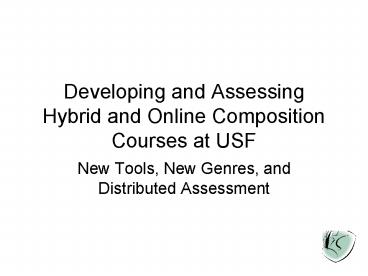Developing and Assessing Hybrid and Online Composition Courses at USF - PowerPoint PPT Presentation
1 / 17
Title:
Developing and Assessing Hybrid and Online Composition Courses at USF
Description:
Developing and Assessing Hybrid and Online Composition Courses at USF ... Build a comprehensive online composition course. Make use of collaborative technology ... – PowerPoint PPT presentation
Number of Views:51
Avg rating:3.0/5.0
Title: Developing and Assessing Hybrid and Online Composition Courses at USF
1
Developing and Assessing Hybrid and Online
Composition Courses at USF
- New Tools, New Genres, and Distributed Assessment
2
Our Four Goals
- Build a comprehensive online composition course
- Make use of collaborative technology and advanced
online writing - Prepare students to participate in and analyze
new online genres - Grow as teachers of writing and critical users of
technology
3
Distributed Assessment
- The five instructors in this project took
advantage of Blackboard to create a shared
learning and teaching space - We graded each others students, but negotiated
our evaluation and criteria - One teacher evaluated the paper another reviewed
the evaluation - Thus, each student document was examined by at
least two instructors.
4
Sharing the Teaching Space
- The five instructors collaborated on teaching
materials, course syllabi, assignments, and
presentations - We taught each other strategies for getting the
most of SharePoint, Blackboard, and Weblogs - We had online discussions about our problems and
shared our insights - We used advanced Word features to facilitate the
peer review and revision processes
5
SharePoint
- SharePoint is a Microsoft product that
facilitates online collaboration - The advantage of SharePoint is its modular
structure, which allows teachers to easily share
teaching materials - We used SharePoint to create and edit important
course documents and assignments
6
Sharing with SharePoint
7
Blackboard
- Blackboard made it easy to share assessmentwe
could see each others grades and privately
discuss student work - Blackboard allowed us to keep student work secure
and private - Blackboard provided us with a forum for
interacting with students and colleagues
8
Blackboard forums and grade discussion
9
Weblogs
- Weblogs, or simply Blogs, are journals that are
published to the web rather than kept in a
notebook - We directed student blogging by providing
students with prompts pertaining to the readings - We enhanced student involvement by asking them to
comment on each others blogs
10
Student and Teacher Blogs
11
Microsoft Word
- Many Microsoft Word users are unfamiliar with its
powerful peer reviewing features - These features, called Track Changes and
Comments, allow students to comment on each
others work - They also allow students to preserve the changes
so teachers can later review them to get insight
into the students writing process.
12
Word Comments
Word makes it easy to record frequently used
comments and easily copy them wherever they are
useful
13
Successes
- Students improved their writing by
- Helping each other with online collaborative
software - Preserving an easily accessible record of all
changes, comments, and graded comments - Creating a final portfolio of their revised
documents
14
What We Learned
- Communication is key we would advise other
teachers to carefully discuss their plans and
methods well in advance of the course - Sharing Authority is key we must not make
decisions that affect the course without first
discussing them with the group - Monitoring Students is key we learned that some
students in online courses need personal
attention via email and possibly phone calls if
they are to stay on task - Keeping it Simple is key we learned that the
best technologies are also the easiest to use.
15
Checklist for Online Students
- __ Students should be comfortable working in an
online environment and dealing with inevitable
technical difficulties. - __ Students should understand that online classes
are not easier or less intense than traditional,
face-to-face courses - __ Students should be self-motivated and not
require the social pressure of a physical
classroom and teacher to do their work.
16
The Future
- Better integration
- Students and teachers desire a one-stop shop
instead of relying on multiple of websites and
resources - Better accommodation
- Online courses should be more flexible to better
serve non-traditional or working students with
unpredictable schedules - Better portability
- Teachers should have access to high quality
laptops that allow them to teach-on-the-go and
not worry about sharing computer time with
students and colleagues in the campus computer
labs
17
Thank You
- Thanks for visiting our booth and viewing our
presentation! - Contact us
- Matt Barton mdbarto2_at_mail.usf.edu
- Daisy Pignetti dpignett_at_taa.usf.edu
- Greg Smith gregvsmith_at_tampabay.rr.com
- Patty Remmell premmell_at_tampabay.rr.com
- Wed love to hear from you!































